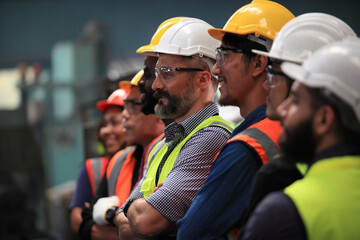In workplaces where hazards are part of the job, the role of OSHA regulations in protecting the workforce can't be overstated. One of the cornerstones of these regulations is the meticulous guidance on Personal Protective Equipment (PPE). For construction workers, safety officers, and workplace managers, keeping abreast of these regulations is vital for ensuring safety.
In this extensive guide, we'll unravel the complexities of OSHA regulations about PPE, empowering you with the knowledge you need to create a safer work environment for everyone. From understanding the core principles of OSHA standards to a detailed breakdown of various PPE types, this post serves as an indispensable resource for all professionals in high-risk industries.

Site-Specific Safety Plan Template OSHA Compliance
When starting a new construction project, creating a comprehensive site-specific safety plan is not just a good practice—it's often required by OSHA to ensure the safety and health of everyone on the job site. This detailed document serves as a blueprint for identifying potential hazards and outlining safety procedures that are tailored to the conditions and risks associated with a specific project.
For a project manager or general contractor, the site-specific safety plan documents key components such as hazard communication strategies, the location of first aid kits, emergency situation protocols, and accountability measures for ensuring that safety procedures are followed. It also delineates the responsibilities of all parties involved in the project, from the general workforce to supervisory roles, ensuring everyone knows what is expected of them regarding safety.
This plan should include thorough documentation of all safety measures to be performed, how emergencies and injuries should be reported, and the specific responsibilities each team member has in maintaining a safe work environment. Furthermore, it fosters a culture of safety that prioritizes the well-being of workers, making it clear that health and safety are top priorities that require conscientious attention and adherence to established procedures.
Questions regarding the implementation of the safety plan or the specifics of required safety procedures can often be answered through reference to this document, making it an essential tool for maintaining regulatory compliance and promoting a culture of accountability and safety on every construction site.
The Bedrock of Safe Working Environments
Before we dig into the specifics of PPE regulations, it's worth highlighting the pivotal role of the Occupational Safety and Health Administration (OSHA) in setting the bar for workplace safety. Created to prevent work-related injuries, illnesses, and fatalities, OSHA standards are the foundation on which credible safety programs are built.
In essence, OSHA's mission is to ensure employers provide a safe environment for their workers. Oftentimes, this means mandating the use of protective gear to mitigate risks. Understanding and adhering to these regulations isn't just about compliance—it’s a commitment to preserving the well-being of the workforce.
The Comprehensive Guide to OSHA Regulations for PPE
Defining Personal Protective Equipment
Personal Protective Equipment includes a variety of items designed to protect workers from occupational safety and health hazards. PPE is used in a multitude of industries, such as construction, manufacturing, and healthcare, and serves to act as a barrier between the user and potential hazards in the work environment.
The scope of PPE can be broad, encompassing gear to protect against physical, electrical, chemical, and biological hazards. It's important to emphasize that PPE should be considered a last line of defense, with administrative controls and engineering solutions taking precedence wherever feasible.
OSHA Standards and Guidelines
OSHA provides a wealth of resources regarding PPE requirements specific to different sectors. These standards are not only industry-specific but also cater to the risks associated with particular job roles within these sectors.
For example, construction is one of the most hazard-prone industries, and OSHA’s standards reflect the need for comprehensive PPE usage. Regulations encompass fall protection, head and eye protection, and other gear essential for various tasks. By contrast, the healthcare industry's focus might pivot more toward the use of gloves, gowns, and masks to protect against pathogens.
Understanding how OSHA standards manifest in these different environments is crucial to developing an effective PPE program that meets the specific needs of those sectors.
Head Protection
One of the most recognizable forms of PPE is the hard hat—ubiquitous on construction sites. OSHA standards for head protection require that employers provide headgear that meets specific ANSI performance requirements and conduct a hazard assessment to determine when head protection is needed.
Eye and Face Protection
In industries where eye injuries are a substantial risk, such as metalworking or carpentry, the relevance of proper eye and face protection is prominent. OSHA insists on the use of protective eyewear that complies with ANSI standards and offers protection from impact, as well as chemical and radiation hazards.
Respiratory Protection
Respiratory protection becomes paramount in work environments contaminated by dust, fumes, or airborne pathogens. OSHA's regulations on respiratory PPE cover everything from fit-testing and training to the type of equipment necessary for specific contaminant levels.
Hand Protection
The versatility of gloves as a form of PPE is reflected in their use across a vast array of industries. Whether it's to protect against cuts, chemical exposure, or temperature extremes, OSHA stipulates that employers must provide suitable gloves and training on their use. Selecting gloves that are the proper size and material can significantly enhance their protective characteristics.
Foot Protection
Jobs that involve heavy materials or sharp objects on the ground require robust foot protection. OSHA's foot protection requirements include the use of safety-toed shoes, metal insoles, and other specialised footwear based on the identified workplace hazards.
Hearing Protection
Hearing loss is a common and debilitating occupational condition, but it's also largely preventable with the right PPE. OSHA's guidelines for hearing protection dictate the use of earplugs or earmuffs in loud environments and the calibration of noise levels to determine the necessity and efficacy of these devices.
Increasing Compliance and Ensuring Safety
Training and Awareness
Simply providing PPE isn't enough. Employees must be trained on why and how to use it. OSHA mandates that employers conduct regular refresher training sessions, especially when new types of PPE are introduced or when the workplace changes, potentially introducing new hazards.
Inspections and Penalties
OSHA conducts routine inspections to ensure workplaces are compliant with PPE regulations. Employers found to be in violation can face hefty penalties, and in severe cases, criminal charges. Regular self-audits and compliance measures can stave off these repercussions and, more importantly, protect workers.
Site-Specific Safety Plans in Construction Projects
To enhance safety measures on construction sites, it's crucial to have Site Specific Safety Plans (SSSP). These safety plans are tailored to address the unique hazards and requirements of different locations, ensuring that all possible risks are identified and mitigated. Each plan must include a comprehensive list of potential dangers, alongside the safety protocols to be followed to prevent accidents. Based on the collective experience of safety officers and project managers, these plans should be regularly revised to reflect any changes in the scope of work, introduction of new equipment, or updates in OSHA regulations. This section of our guide serves as a critical resource for understanding how to efficiently put such plans in place, ensuring that every construction project is as safe as possible for everyone involved.
Site-Specific Safety Plan Tem
Reaping the Rewards of Compliance
Reduced Injuries and Accidents
An unequivocal benefit of a robust PPE program is the reduction in the number and severity of workplace injuries. By providing and enforcing the use of appropriate PPE, employers minimize risk and create a safer working environment.
Legal Implications and Liabilities
In the unfortunate event of a workplace accident, adherence to OSHA regulations can also serve as legal protection for employers. Following these guidelines demonstrates a commitment to workplace safety that can be influential in legal proceedings.

Conclusion
Summary of the Essentials
Navigating the labyrinth of OSHA's regulations for PPE may seem daunting, but it’s a necessary and rewarding endeavor. By understanding the standards and guidelines, you equip your team with the tools to perform their jobs safely. Engagement, education, and enforcement of PPE policies are not just directives—they are a testament to your organisation’s dedication to worker welfare.
In a world where each workday carries the promise of hazards, knowledge is power and adherence to OSHA’s regulations is the safeguard. Whether you’re a laborer on the front lines, a manager enforcing safety protocols, or a safety officer setting the tone for the worksite, this comprehensive guide will bolster your expertise in all things PPE-related. Comprehension of these pivotal regulations doesn't just protect employees; it secures the future of a workplace free from the specter of avoidable injuries and tragedies.
